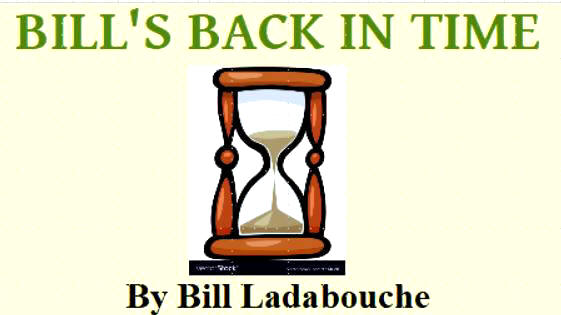
BILL'S [Somewhat] WEEKLY COLUMN/BLOG PAGE

GOOD ‘OL BUTCH
Since the passing of Butch Jelley in May, 2020, I felt compelled to take this article from 2013 and improve it, in his honor.
I spent much of my first evening at Devil’s Bowl, since 1987, with CVRA veteran Butch Jelley, originally from Andover, Vermont. If you haven’t happened to get up close and personal with clay oval dirt track racing, it is a whole different thing than asphalt [and very hard on the body]. And…. It just so happened that Butch’s body had turned 65 just days before that evening. Nonetheless, he took one of the first PMC cars ever built – one done for Billy Decker in the 1990’s – and kept up with the younger drivers, many of whom had much more heavily – financed and current cars than his.
Despite his hall of fame status. Butch Jelley was one of those guys who made anyone who approached him feel comfortable. The last time I spoke with him was at Devil's Bowl in 2019, and he was in poor health. I doubt he could even recall who I was anymore, but he was still just as congenial as ever. We lost him in early May, 2020.
Ladabouche Photo
Butch [center] listens to Ed Fabian talk to
Frank Hoard, one of Butch’s
contemporaries in the dirt track veterans’ ranks. Below – The PMC Butch
would run at Devil's Bowl on a number of occasions.

Marty Kelly Jr.
Photo
Thanks to the folks at Bennington Furniture, Butch had been able to continue a brilliant career for yet another year, [this was 2005] driving his own Number X, sporting the skunk in the middle of that X in memory of his late car owner, Martin Riiska, of Winfield, Connecticut, whose car X’s with the little skunk were legendary up to at least the 1970’s. “Bevy’s Chevy”, as that most recent car was affectionately called, was so named for Butch’s bride of many years, Beverly. The X doesn’t sport much of a crew. Doreen, the manager back at Butch’s quick stop and deli near Londonderry, and a fellow named Mike were doing what they could that evening; but, Butch ended up having to handle most of the technical work.
Ladabouche Photo
Londonderry, Vermont’s Henry Abbott, a damned
good wheelman in his own right and former husband of Bevy Jelley, sits in
his fast coupe, waiting for a wrench at the old Fairmont Speedway. He and Butch
were classmates
in the small school system there – in the 1950's. He also just happened to be
Bevy's first husband.
It is apparent that more than a few people in the pits at Devil’s Bowl, in 2005,
still knew who Jelley was and would stop by his car for occasional advice. But,
one of my favorite examples of this happened back in the 1970’s at Devil’s Bowl,
when Eddie Allen – who was then running a former Rene Charland [Fred Rosner –
built] car came to ask Jelley what gear he was running. “The right one” was
Jelley’s cryptic response. Back then, Jelley was running more for a living and
less for the personal satisfaction.
Butch started in 1957 with the Claremont Jalopy Owners and Drivers Association, at around 17 years of age. He had a typical jalopy at Sonny Fleury’s sandy New Hampshire track within what seemed to be a giant sand pit. The car was an absolute death trap, with the gas tank being a five gallon can wired to the roll cage, with a hose coming out of the top – sealed only with a rag. I recall seeing some old newspaper results and there – in the results of one heat – sat the name “Clarence Jelley”. There is no other record of that early adventure.
Cavalcade of Auto Racing Photo
Butch came to Claremont with a jalopy
probably a lot like this one, of Robert Hodgman. Below – Buddy Bardwell’s
Fairmont – winning car. It was Ford – rare for the Hudson enthusiast. It may
have been, at one time, a pavement project for him he wanted to use at Thunder
Road.
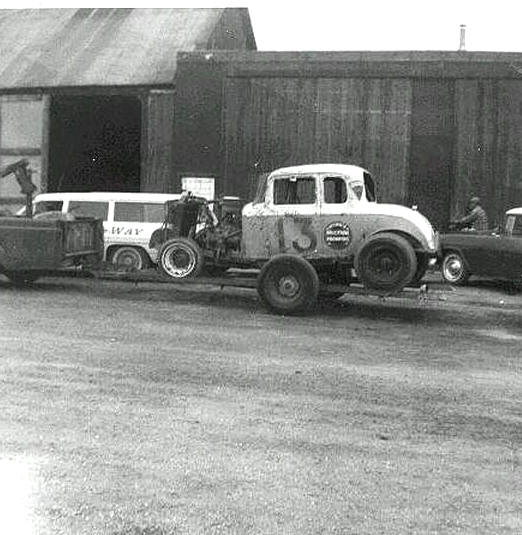
Ladabouche Photo
The only one in the Claremont establishment who would help out a green teenager from Southern Vermont was Buddy Bardwell. I guess if you would get to pick out who would offer you advice, Buddy would be that person. Their paths would cross, one Memorial Day, in the early 1960’s, when C.J. Richards re-opened the old Fairmont Park Motor Speedway in Fair Haven, Vermont. Butch’s #Y would win a qualifier that day; but, Buddy would win the feature.
After the jalopy experience, Butch made the acquaintance of Ed Winn, of Williamstown, MA. – just a few miles south of Jelley’s new home town of Pownal, Vermont. Wynn, a bachelor with no family ties to speak of, ended up becoming a sort of father figure to Jelley, whose only other source of racing help was his sister, Joanne, the future Mrs. Chuck Ely. She was not averse to helping her brother pull a rear end from a car or change engines. I recall one of the Jelley sisters in his pits, always calling him “Clair – unce”
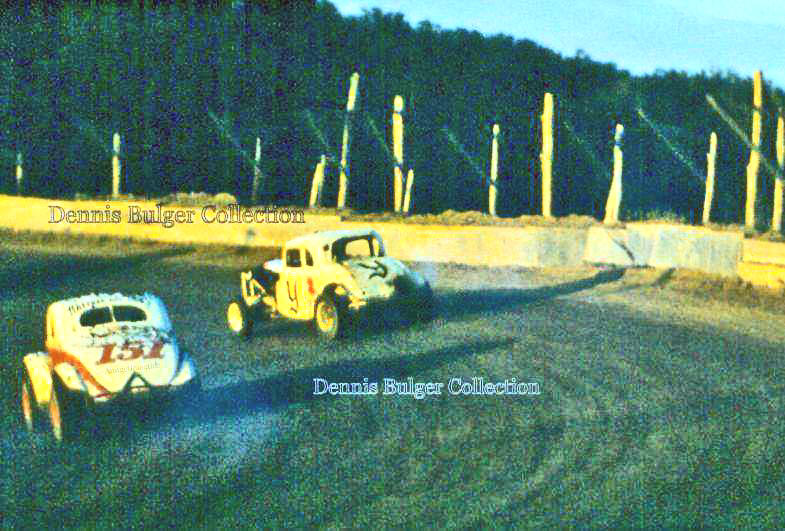
Dennis Bulger Collection via Chas Hertica
Butch takes to the high side on the Valley's
banks to race with
East Greenwich, NY's Don Leffler. Below -
The later Ed Winn Y, at the inaugural
Fairmont Speedway program in 1962.
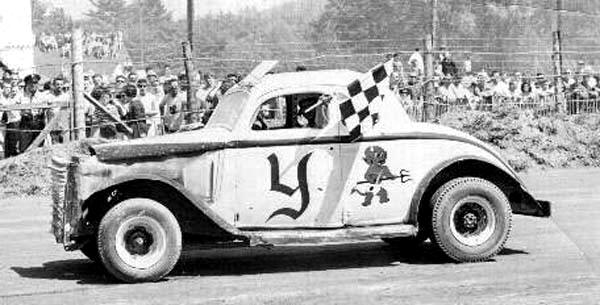
Bob Frazier Photo Ladabouche Collection
Butch started out for Winn with a early '30's flat top coupe – lettered and painted similar to that Y he brought to Vermont first in 1961 and then to Fairont a year later. A photo of that earlier Jelley car shows him racing at Lebanon Valley against Don Leffler, another man who appeared in that first Fairmont show in 1962. Winn, who had already earned a big reputation in racing behind Charlie Morse and the #467, owned the familiar yellow and white 1937 Ford coupes which turned out to be Jelley’s Y and Frank Hatch’s M2. Jelley learned mechanics from Winn and toughness from the grizzled war vet, Hatch.
The Y was a favorite with the kids because of the red cartoon devil character painted on the side. That car was a very special race car. The Y on the side, according to Butch, could have represented the philosophy of the team back then: “Y not ?” Or, it might have re[resented the unusual exhaust system developed by one of Winn’s friends, an engineer in Massachusetts. The pipes coming back from the engine eventually formed a sort of Y shape – and it was developed to become gradually larger as it neared two football – sized holes in the trunk lid of the race car in the rear, thus creating a sort of Venturi effect.
 |
|
Ladabouche Photo
Hatch’s M2 was the team mate to Jelley in
the early 1960’s.
In this photo, Butch has taken the M2 to run at
Fairmont after his Y was wrecked,
Below – The Y eventually came to an unfortunate
demise at the Valley.
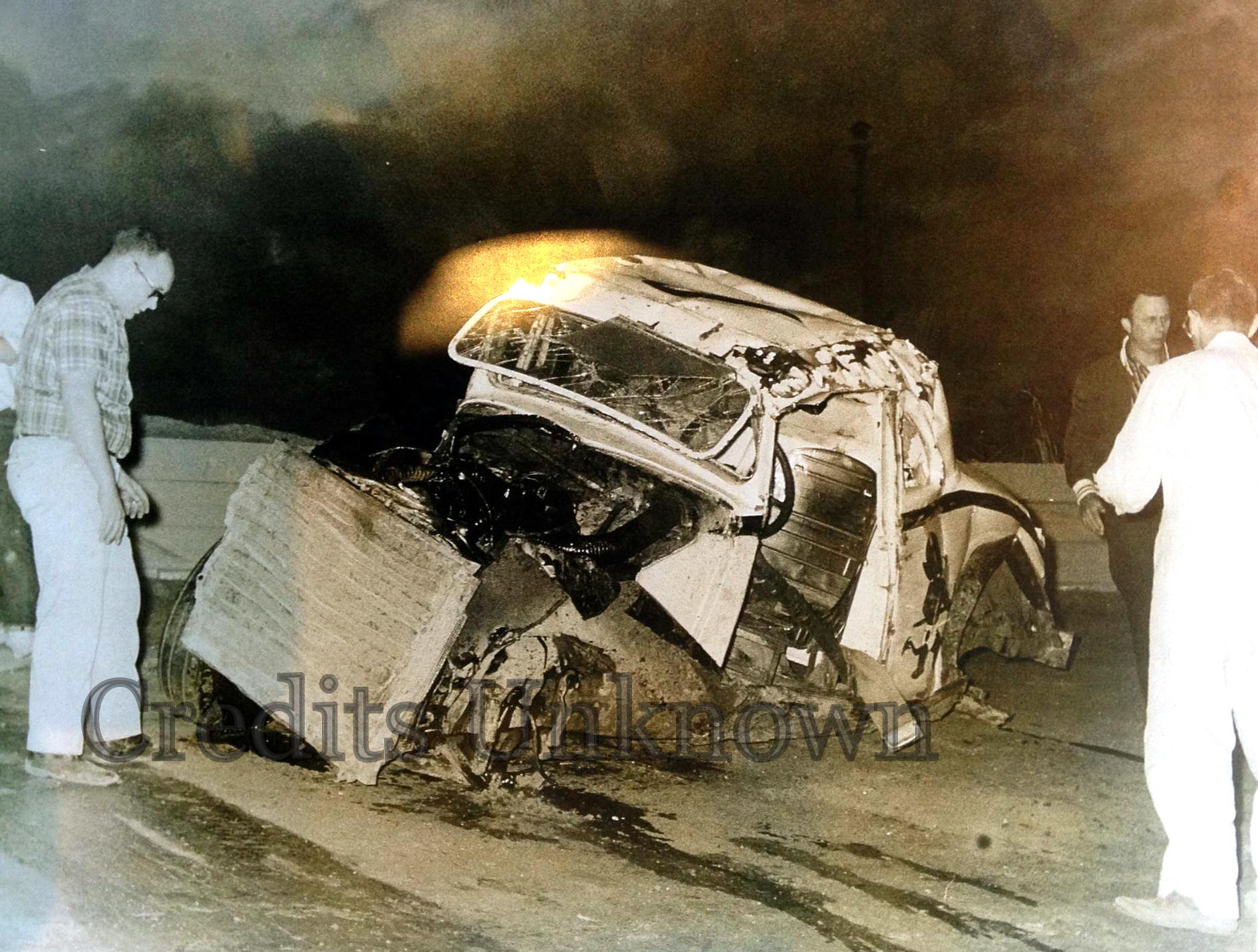
Jeff Ackerman Collection via Chas Hertica
When Jelley, who was burning alcohol at the time, in the early 1960’s, would race down the front stretch and let off the accelerator, the backfire would ignite unburned fuel buildup in those larger rear pipes and flames would shoot out in the rear. Jelley says he was running Lebanon Valley one night in 1960 when then – newcomer Karl Hauessel commenced running closely behind him in one heat. At the end of the race, an exasperated Hauessel came up to Butch and protested, “Jesus Christ, kid, that thing like to melted my radiator off !”
_John Grady Photo
The normally affable Karl Hauessel, shown here with his best –
known car the 900 , got to run against Jelley without
the flames at Lebanon Valley, Fonda, and Devil’s Bowl. Below -
Cars seen in this rare 1961 photo of the Valley show at
the Vermont State Fair. Jelley would race against the
Yellow X of Martin Riiska, Butch's next big ride.
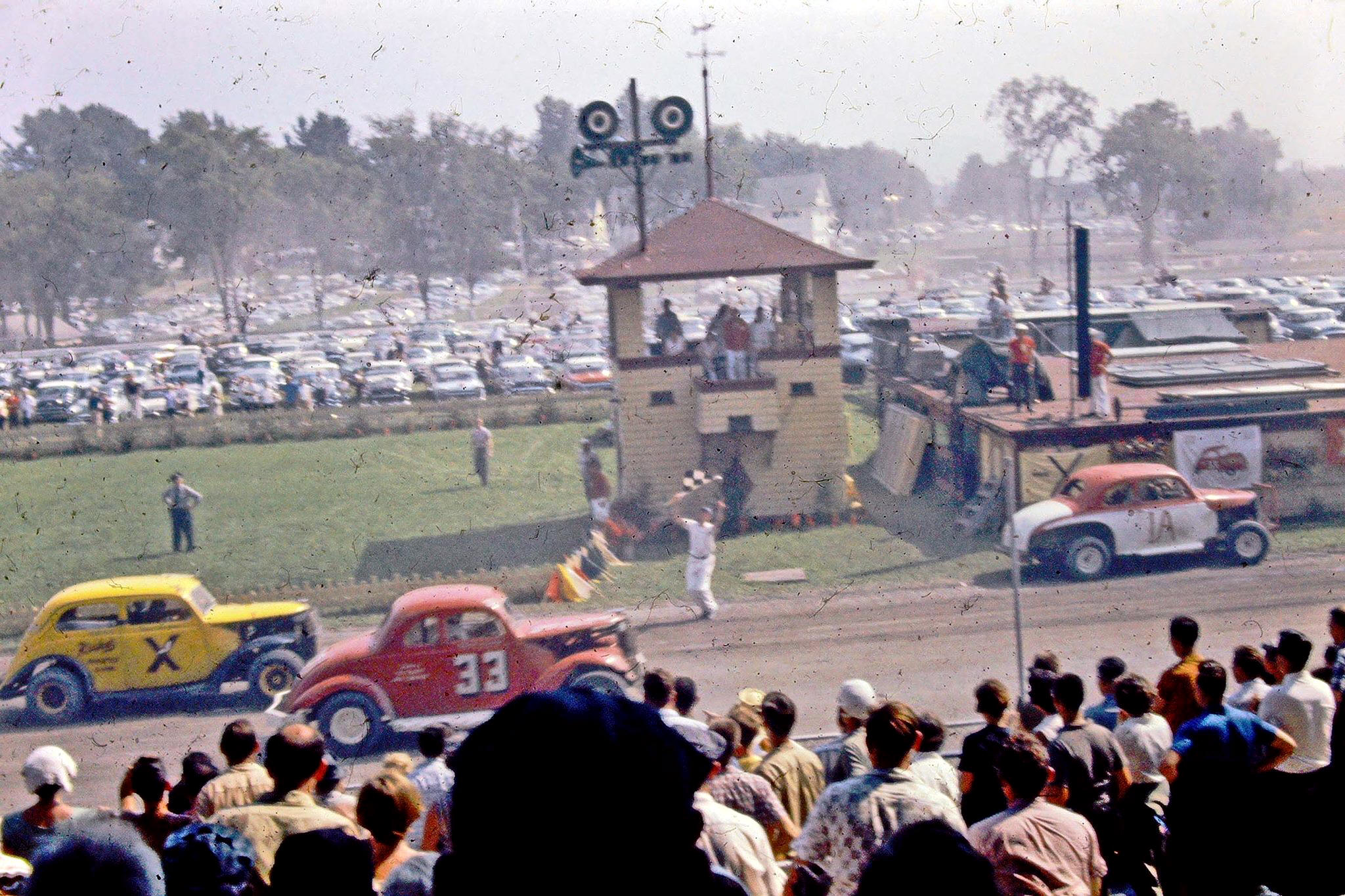
Source Unknown [Apologies, I Lost
It]
The Y was first seen in the Rutland, VT area when Lebanon Valley staged a stock car show at the Vermont State Fair, in 1961. Knowing he would have a race track the following year, C.J. Richards may have encouraged this event to happen, to stir up interest in stock cars that had stagnated after years of no tracks operating in the area. Jelley always maintained that the show was staged and the outcome predetermined, because of the unsafe fair track conditions. At any rate, the race that afternoon was convincing and the area fans were introduced to Jelley.
Martin Riiska would eventually become the second car owner to become somewhat of a father figure to the still – young Butch Jelley. The Winstead, Connecticut man, like Wynn before him, had little or no family to take up his time or energies. His racing operation was everything, and much of his efforts would be based on bringing along the young Vermont driver when he would take over the seat of the various Yellow X’s from the veteran and legend Doug Garrison [who had gone over to the equally – famous Gordon Ross 19]. Jelley had appeared often as a competitor to Garrison, Riiska, and the Yellow X operation. But for that year and that program, Garrison would be Riiska's focus and Jelley's competitor.
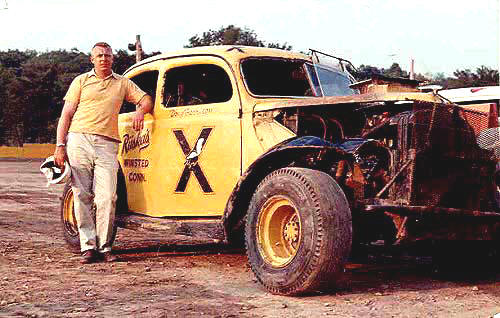
Arnie
Ainsworth Collection
Jelley faced Doug Garrison, in this car – to
be his future racing team on Garrison’s departure.
Below – Don Rounds, also at Rutland in 1961, disagrees that the race was pre –
arranged.
Here, he visits with Sonny Rabideau [right]. I wonder if they discussed
Rabideau’s trip into the fence.
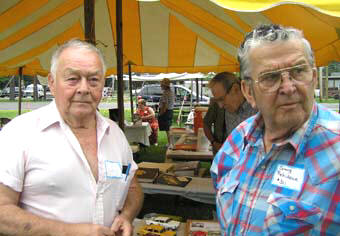
Ladabouche Photo
It became immediately apparent to everyone – on both sides of that agreement – that nobody knew what they had gotten themselves into. The track was absolutely not ready for high – speed automotive competition with anything larger than perhaps a midget car. The rail fences were simply boards, like one would find at a horse farm, and were old, at that. Roxie’s French Fry stand sat – just off turn two, its propane tanks mere feet from those inadequate fences. Spectators used to lining up near Roxie’s to cop a free view of horse races or demo derbies were pressing in next to those old fences, as well. The track surface was gritty and the ancient 1930’s water truck could not keep up with the afternoon sun.
When Jelley and his competitors arrived in the infield of the track for a makeshift pit area, they were greeted by starter Teddy Ryan and a glum assessment of the chances for even a remotely safe competition that day. As a huge and expectant fair crowd [including an excited yours truly] sat, unaware of the problems unfolding before them across the track, a unique solution was contrived:
a.) the propane tanks would be moved further away from the fence;
b.) extra cops would keep the crowd away from all fences
c.) the track would be watered as much as possible, even if it meant limiting practice time
d.) Drivers would employ the technique of determining where they were on the dusty track by keeping an eye on the white wooden fences along the outside of the track
e.) and, most importantly, an agreement was made that every single would get an equal share of the prize money in return for the understanding that the race finish would have to be scripted, and the finishing position would not be of any significance to the payout. In short, just like a pro wrestling program, put on a good show, try to get through without anyone getting hurt, and we all will win.
Lebanon Valley Classics
Joe Messina, running this very car, took the
win at the Vermont State Fair in 1961.
Below – The grossly inadequate fair water truck, as it looks restored around
2012.
Courtesy of Manuel Guixens
New Yorker Joe Messina, a Hudson driver, got the nod to be the winner that day; the crowd enjoyed a hot, dusty, sunburned good time; and Messina trailered his #13 Hudson home with no more money than the guy in last place. The only problems were two: Ray Chapman, in the #18, forgot the fence – watching method and ended up going through a section of it in the warmups; and the Valley drivers, resentful of an intrusion from Claremont driver Sonny Rabideau, put him into the fence in turns one and two, barely missing Roxie’s propane tank.
Jelley, in Ed Winn’s Y, raced against his future ride, Riiska’s Yellow X [a big hit at the race that day] with Doug Garrison at the controls. People in that region got a little preview of the racing that would return with C.J. Richards’ Fairmont Speedway in less than a year. More importantly, no drivers or spectators were killed or injured – an accomplishment that was not repeated when other organizations.
|
Bob Frazier Photo Norm Vadnais
Collection
Frank
Hatch, ex – Marine and team mate to Jelley would delight theFairmont crowds by
honking a horn on his car if he won a race. Below – Butch returned to Fairmont
another year with this car, which may not have been A Winn team car.
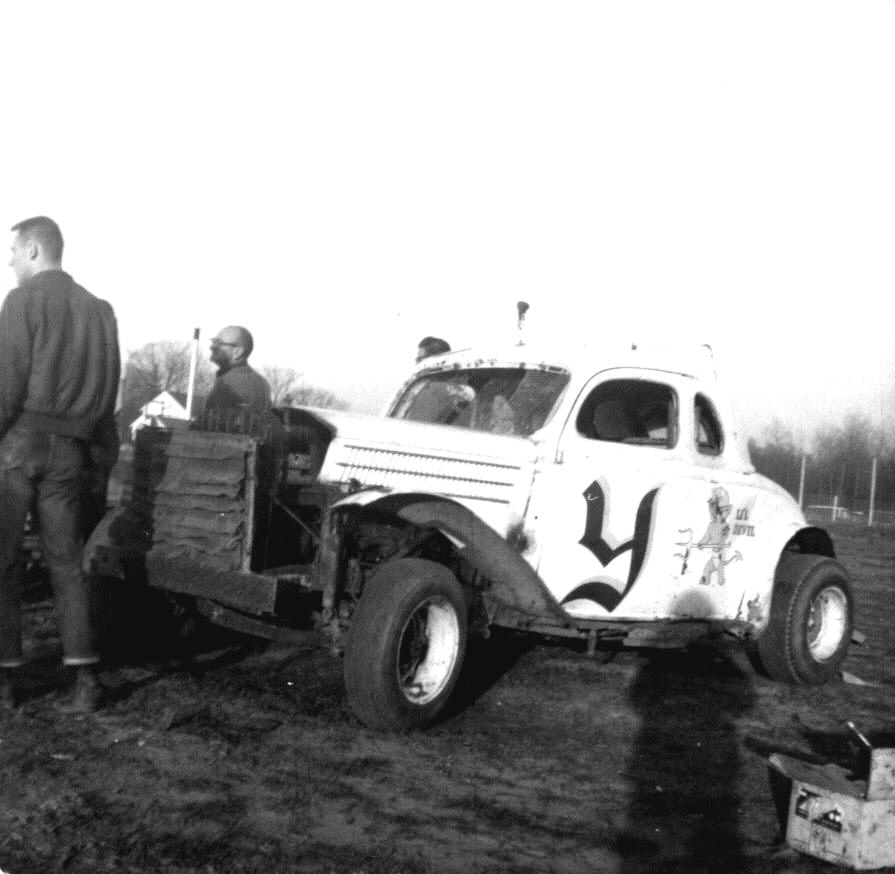
Ladabouche Photo
Butch took that same yellow and white ’37 Ford to the re – opening of Fairmont Speedway in 1962. he won the large consolation race, and made a number of fans, between the red devil and flame – belching. Hatch, with the M2, won the high handicap qualifying heat, that same day. The heavier and more powerful cars, such as the two Winn Fords, did not fare as well in the feature, as the lower, much lighter, and very potent flathead Fords from the Claremont Speedway held the day.

Arnie Ainsworth Collection
One of the earliest version’s of the Riiska car that Butch drove.
It is still in that upright coupe era. Below - The Riiska Falcon
was one of the more iconic Jelley rides. Here, it is seen
unloading at Devil's Bowl with Martin at right.
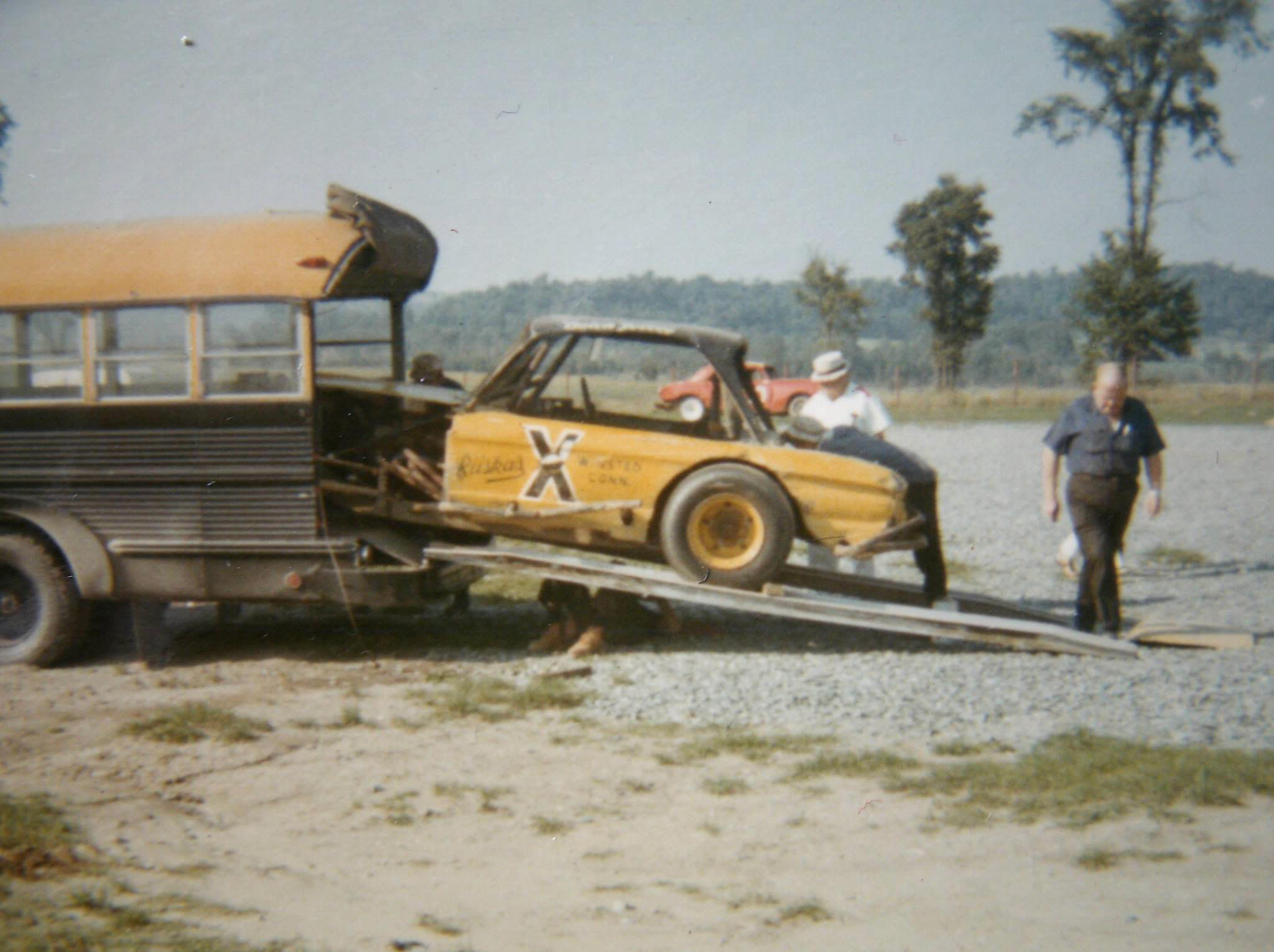
Courtesy of Cliff Haynes
That first afternoon race would begin an extremely long and sometimes spotty relationship between the extended Jelley family and C.J. Richards’ CVRA sanctioning body. But few families would be any more consistent CVRA supporters than the Jelley/Ely clan. Butch would continue on through the Y era, and entire stint with Martin Riiska’s legendary X car out of Connecticut, through years with the Austin Dickerman 357, assorted stints with other car owners, and – finally – with is own cars. Other family members including Wayne Jelley, Lyle Jelley and brother – in – law Chuck Ely all turned many laps in the CVRA.
One of the more memorable eras in Richards' tenure and the CVRA was that period when Will Cagle dominated the track with a Bob Rossell – built, square tubed sedan that everyone assumed was illegal. It was found not to be off at all when purchased by a local man and examined. Jelley would occasionally get the seat in that car when Wily Will was elsewhere – before Cagle sold the car. Few people got to drive Cagle equipment besides Will.
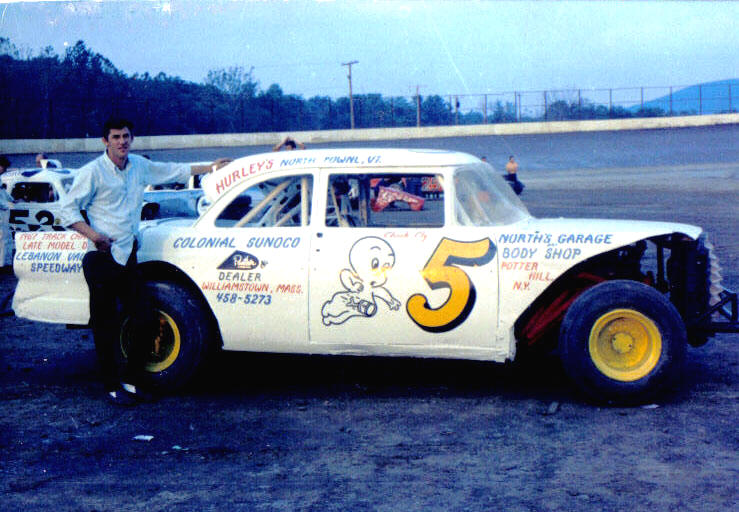
Courtesy of Arnie Ainsworth
Renaissance man Chuck Ely, driver, sign painter, and
photographer – with arguably
his best – known car, the Casper #5 Valley late model. Below - Butch, with the
infamous
Cagle sedan.
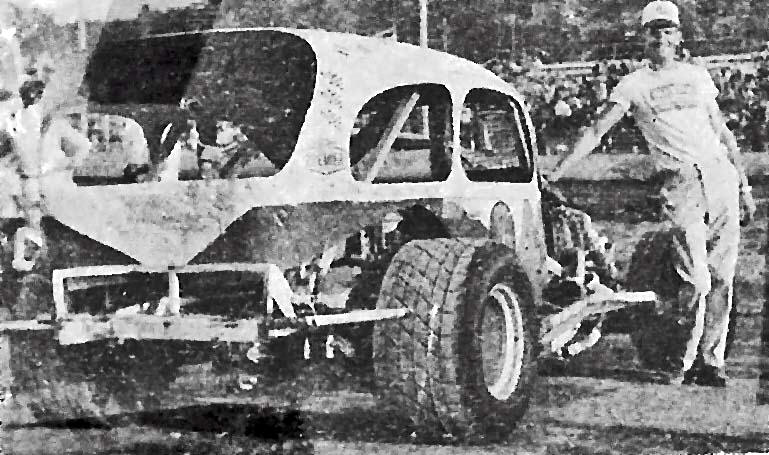
Cavalcade of Auto Racing Photo Ladabouche Collection
Butch’s presence in the CVRA was sometimes very influential. I can recall a meeting upstairs in a building in Fair Haven, Vermont around 1985, when Richards, aware that the expense of racing big blocks was killing his program, decided to take the risk of his long career and discard the big motors, instead going exclusively with the 358 C.I. and lower – cost engine components. Jelley was a prominent speaker at this meeting and had a lot to say about the less – expensive components part of decision. After a rough first season, the 358’s are still going strong today.
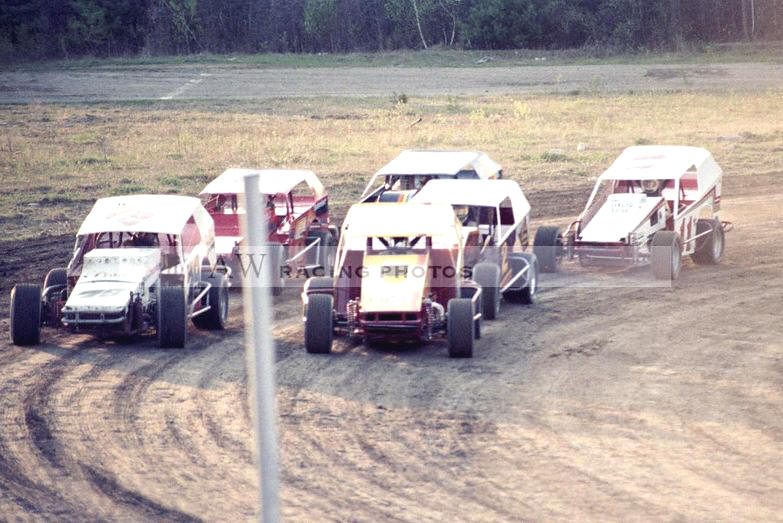
A and A Ward Photo
C.J.’s 358’s in action in 1985. Butch had a lot to say
in the creation of a very lasting engine idea. Below -
Driver's like Vermonter Matt Waite were able to
compete more fairly with the new CVRA rules.
Courtesy of the LaFond Family
Jelley was very quick to point out that – while the press likes to make heroes out of the race drivers – it was his belief that the real heroes are the mechanics, sponsors, car owners who put the cars on the track for the fans. He is convinced that the drivers of the past were clearly a different breed than those of today – many of whom simply step out of clean dress clothes, into a clean driver’s suit and drive perfectly – tuned cars under directions from crew chiefs and spotters.
Butch said his kind of stock car driver was, at once, an engine builder, fabricator, chassis tuner, and agent, and a good seat – of – the – pants driver – because nothing was handed to them in the past. Even in the excellent arrangement he had with Martin Riiska for so long, Jelley was hands – on at all times – sometimes taking the car to venues almost by himself and recruiting help, once he was there. Most of today’s drivers wouldn’t know the first thing about that now.
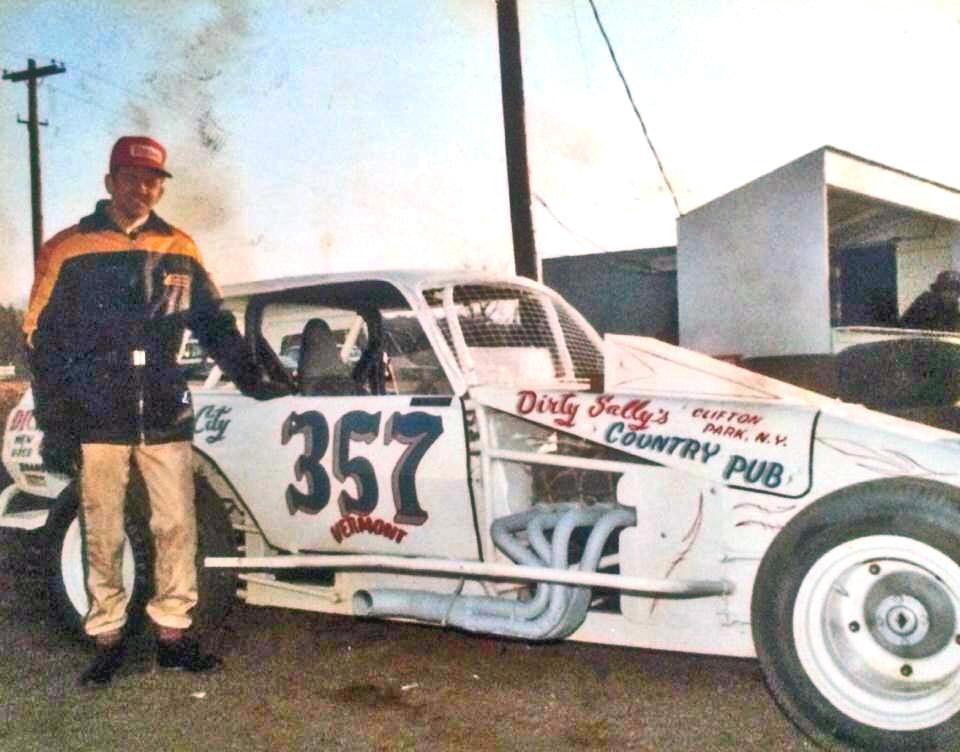
John Grady Photo
Butch had a great run – particularly at
Fonda – with Austin Dickerman’s 357 Vega wagon. Below – Butch was
one of the few entrusted to drive Will Cagle’s personal equipment. Here, he was
tapped to drive a
car for builder and former driver Dexter Dorr.
Courtesy of Midstate Auto Club
Only someone who has run in the earlier years of racing – and still drives today – could appreciate these stories he has experienced. Jelley has driven at so many tracks that he cannot recall them all. He claims to go back to the days of Pico Raceway, near Rutland, VT and the very earliest Lebanon Valley days – but his age at the time would suggest he must have been a spectator. He has run at the Valley, Claremont, Fairmont, Rainbow Ridge Speedway, Fonda, Devil’s Bowl, Catamount, southern Canada, and other local tracks. His time with Riiska, Dickerman, and Cagle took him all over the Northeast.
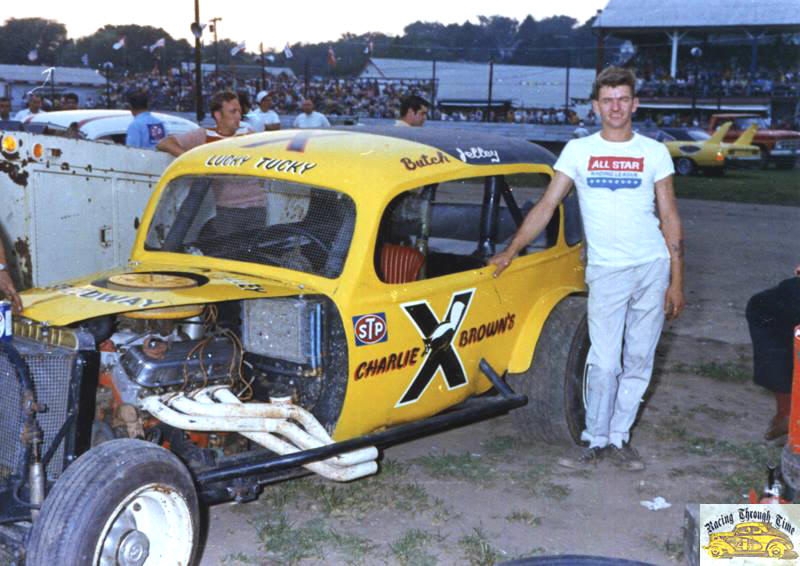
Courtesy of Keith Shoemaker
Butch ran a couple of different Riiska
tribute cars, including one fielded by Devil’s Bowl
regular, Charlie Brown. Below – This X was associated with car owner Arnold
Fleury.
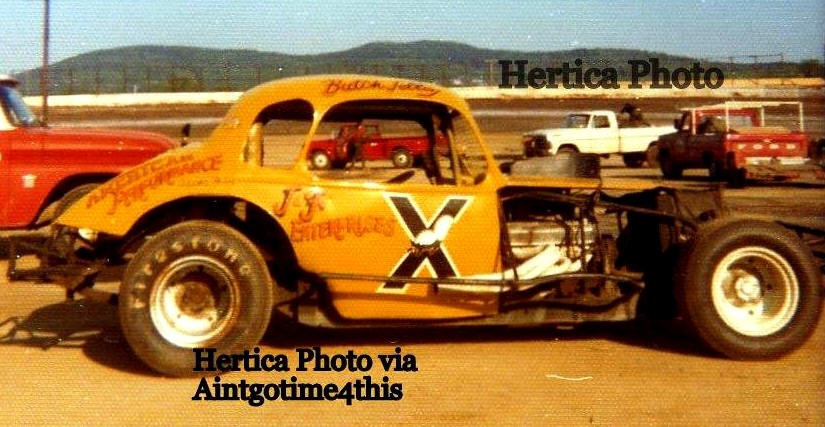
Courtesy of Arnie Ainsworth
After the years running with Riiska and Dickerman, Butch did have other rides – particularly at Lebanon Valley. He seemed to be able to find a seat right up into the 2000's, when he basically ran his own equipment. He won championships and various other titles at the Valley, Fonda, and Devil’s Bowl – to name a few. He has been inducted into the New York Stock Car Association Hall of Fame. The back of Butch Jelley’s 2005 modified read “Respect Your Elders”. That, above all, says it best in Butch Jelley’s case.
Please email me if you have any photos to lend me or information and corrections I could benefit from. Please do not submit anything you are not willing to allow me to use on my website - and thanks. Email is: wladabou@comcast.net . For those who still don’t like computers - my regular address is: Bill Ladabouche, 23 York Street,Swanton, Vermont 05488.
AS ALWAYS, DON’T FORGET TO CHECK OUT THE
REST OF MY WEBSITE
www.catamountstadium.com
Return to the Main Page
Return to the Main News Page
Return to the All Links Page
Return to the Weekly Blog Links Page